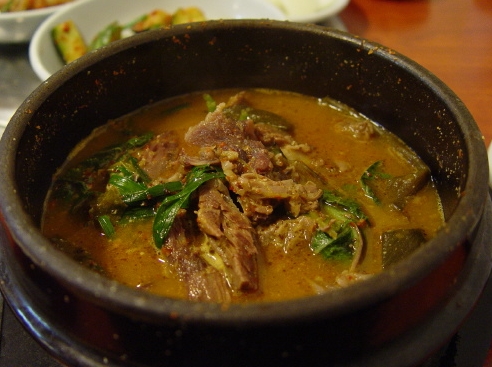Culturally Foreign Foods I Actually Enjoyed
The ammonia-overload instantly hit the senses, released a little more intensely with each chew of the rubbery meat. But what was interesting was how it felt like an entire new way of experiencing food.

I had arguably the most bland palate imaginable growing up. It’s safe to say that I may well have had the same meal for nearly a decade – allowing food to touch on my plate was a major milestone achieved and foreign cuisine was take-out Chinese food. I didn’t even eat salad until college.
Travelers tend to agree that their journeys make up for lost time of some sort, so if that’s the case I’ve lapped the culinary world twice over – I’ll try almost anything once, and I’m not usually disappointed with what I find.
1. Hákarl

This slab of rotten, putrefied shark is a particular prizefighter in the adventure-eater community, as it’s what Anthony Bourdain called “the single worst, most disgusting and terrible-tasting thing” he’s ever tried and Gordon Ramsay actually spit it out. A delicacy of Iceland, Hákarl is the meat of the poisonous Greenland shark that has been killed, buried seaside in gravel for several weeks, and then hung up to further ferment for several more months. When my friend and I sought it out it wasn’t difficult – Hákarl is on the bar menu of every pub and restaurant we visited in Reykjavik.
We were famished, and fought with the logic that maybe on an empty stomach rotten shark meat would be more palatable…but one whiff of the ammonia from a nearby table voided that theory and we ordered a cheese plate and puffin to start (itself an interesting eat) and the Icelandic schnapps-like liquor Brennivín to wash it all down. The Hákarl was served straight-up in an air-tight Petri-like dish, through the glass revealing two distorted chunks of what looked like grayed ham cubes, two toothpicks delicately laid atop the container. As we opened the top the smell immediately wafted indiscriminately, like it had a light of its own. We quickly speared our cubes and began to chew… and chew. The ammonia-overload instantly hit the senses, released a little more intensely with each chew of the rubbery meat. But what was interesting was how it felt like an entire new way of experiencing food. The way that my sense of taste and smell interacted, from my tongue to my sinuses, was entirely re-wired and supremely heightened. We locked eyes the whole time, grinning as we continued to chew before mutually deciding to swig it down. The Brennivín washed the taste away, symbiotically – there was no lingering taste at all. I’d recommend it to the intrepid, but wouldn’t really try it again.
2. Stinky Tofu

Taiwan is renowned for its miles of night markets lighting up the city evening, aromas flitting meter to meter as you walk along sampling SE Asian fare on a dime. Bizarre eats can be found around every corner, ranging from chicken feet to intestines and blood cake. But then as you’re devising a strategy to eat your pork bun and skewered vegetables tempura and deep fried squid, all while not spilling your dipping sauces, something stops you in your tracks. If it’s not garbage or body odor or sewage – if it’s something you can’t identify entirely, then it’s stinky tofu.
The stink of stinky tofu also comes from fermentation, a process that can take up to a week, and the stench is definitely potent. Apparently you can find all sorts of varieties across Taipei, but many of the street vendors offer it deep-fried or grilled with a burst of soy sauce in the middle. Pickled vegetables, a spicy Mala sauce made from duck blood, garlic and other spices can all be added for even more flavor. Once you get past the smell, it’s surprisingly good – not too different in experience from the stinky cheeses of Western Europe.
3. Hvalkjøtt

I’d just finished a part-train-part-ferry-part-camping-part-kayak journey through the fjords of Western Norway and wound up in incredible, breathtaking Bergen, where I stayed with a Master’s student from the local university, Helge. I was completely gutted from days living on nuts, dried fruit and canned fish, so for his hospitality I offered to cook dinner. We headed to the local grocery store where I bee-lined for the deli, craving meat. It was all in Norwegian, but my eyes settled on these two huge chunks of bloody red steaks. It definitely didn’t look like beef – it was cut too thick, and it couldn’t have been pork…
Whale. The environmentalist in me was muted immediately and I ordered the two “hvalkjøtt steaks” right away. Helge quietly asked the butcher for a recipe, admitting that while a 28-year-old Norwegian native, he’d never even tried the dish himself.
There is a lot of controversy surrounding the commercial slaughter and sale of whale meat.The only countries where whaling is still legal include the Danish Faeroe Islands, Iceland, Japan, St. Lucia, St. Vincent & the Grenadines and Norway – and Japan’s whaling practices are currently under review, awaiting a decision later this year.
The butcher told us to prepare the steaks much like we would to grill beef, and cook it to our desired level, raw to well-done. Considering it was seafood, the texture of the steak was surprisingly sinewy like beef or chicken, very meaty. But there was a certain saltiness to it, a distinct fishy flavor underneath the mushroom sauce we’d cooked up. I was an instant fan: feeling truly fed after several physically grueling days down the coastline – the bottle of paired red wine the final piece to lull me into a state of total satisfaction. While still readily available as a Nordic staple, given the international backlash I wouldn’t be surprised to see hvalkjøtt disappearing off menus and out of grocery stores in the years to come.
4. Chicken Hearts

I’m surprised it took me so long to finally channel my inner Khaleesi. Skewered chicken hearts are staples of street markets in SouthEast Asia, but you can really find them on menus or even in grocery stores worldwide. On a recent trip to Japan, taking a break from getting our deliciously radioactive superpowers on, we found a hole-in-the-wall restaurant in the fashionable Shibuya district of Tokyo where we loaded up on Yamazaki Japanese Whisky, the house sake recommendation and all sorts of yakitori (skewered meat).
Enter, every traveler’s favorite guessing game: What’s this food? Each skewer proudly stakes a different part of the animal – leg, liver, breast, whatever. But the hearts are distinctly on display. Tentatively sliding one off of the stick with my chopsticks, I sheepishly popped it in my mouth, chewing delicately. Ms. Targaryen would have been so disappointed. But once I got over the initial texture-shock, I went in for two more. They almost tasted like oysters, but without the sliminess, so almost preferable as far as I’m concerned.
Eat your hearts out.
5. Haggis

In Scotland it’s cold most of the time. Even in the summers it barely gets into the 70’s, so it’s no surprise the national dish is heavy and, well, hearty.
People are generally sketched out by haggis because it’s essentially sheep’s liver, heart and lungs all minced together into a pudding with vegetables and spices, and then encased in a sheep’s stomach (or more modernly, in sausage casing,) to simmer for several hours. The origins of the dish are unclear, but a popular belief is that it was “born of necessity,” as Andrew Zimmern put it, “as a way to utilize the least expensive cuts of meat and the innards as well.” Essentially in poorer times, the “better” parts of the animals were sold off by the farmers, leaving the family to sustain on organs and entrails. So they made it taste as good as possible.
I’m part Scottish by heritage, so I felt particularly under pressure to enjoy this less-than-appealing-sounding dish. So maybe it was the magic of Edinburgh, the lightheartedness of the Scots or, more likely, the drams of 15-year-old Scotch we sipped after hours of trudging around in the January winds, but a steaming pile of very peppery minced “meat” over mashed potatoes somehow seemed like the only way to regain the feeling in my toes and the warmth to my bones.
Unlike many “national dishes,” (the Icelanders aren’t tossing back Hákarl and my Norwegian host Helge had never himself tired Hvalkjøtt) the Scots love haggis. That fact alone almost makes it more appealing. It was on every menu that I saw during my travels through the country and they love to get creative with it. Its extra-peppery flavor makes for a great burger topping or stuffed mushrooms.
6. Gaegogi (Dog Meat):

Disclaimer: I actually thought I ate dog stew once. I’d just recently arrived to Korea and was told in heavily-accented English that there was “duck” in the soup I was eating. Jetlagged and hungry and culturally bashful I just ate it, ashamed to be enjoying it, prepping myself to enter a cocoon of shame back at my apartment.
Contrary to the rumors of the West, Koreans don’t really eat much dog. Its consumption is as controversial here as it is around the world, and only a very small portion of the population eats it regularly. Organizations like Korean Animal Rights Advocates (KARA) actively work to demystify that international belief that Koreans eat dogs, as well as highlight the mistreatment of the dogs raised for slaughter – Nureongi or Hwangu breeds, primarily. While only these few breeds are raised for meat consumption, plenty of people do own these dogs as domestic pets. I’ve been told that among the dog-owner community in Korea, if your pet goes missing, you don’t check the local pound – but the local “dog farm”.
Based on the feedback of people I who know have tried dog meat, overwhelmingly the verdict is rather negative anyway. While there are positive reviews out there, it’s been described to me as slimy, oily, fatty and gamey: just generally unappetizing. So even if I were about to overlook my reservations for a controversial culinary dish, it wouldn’t be for dog. ![]()




